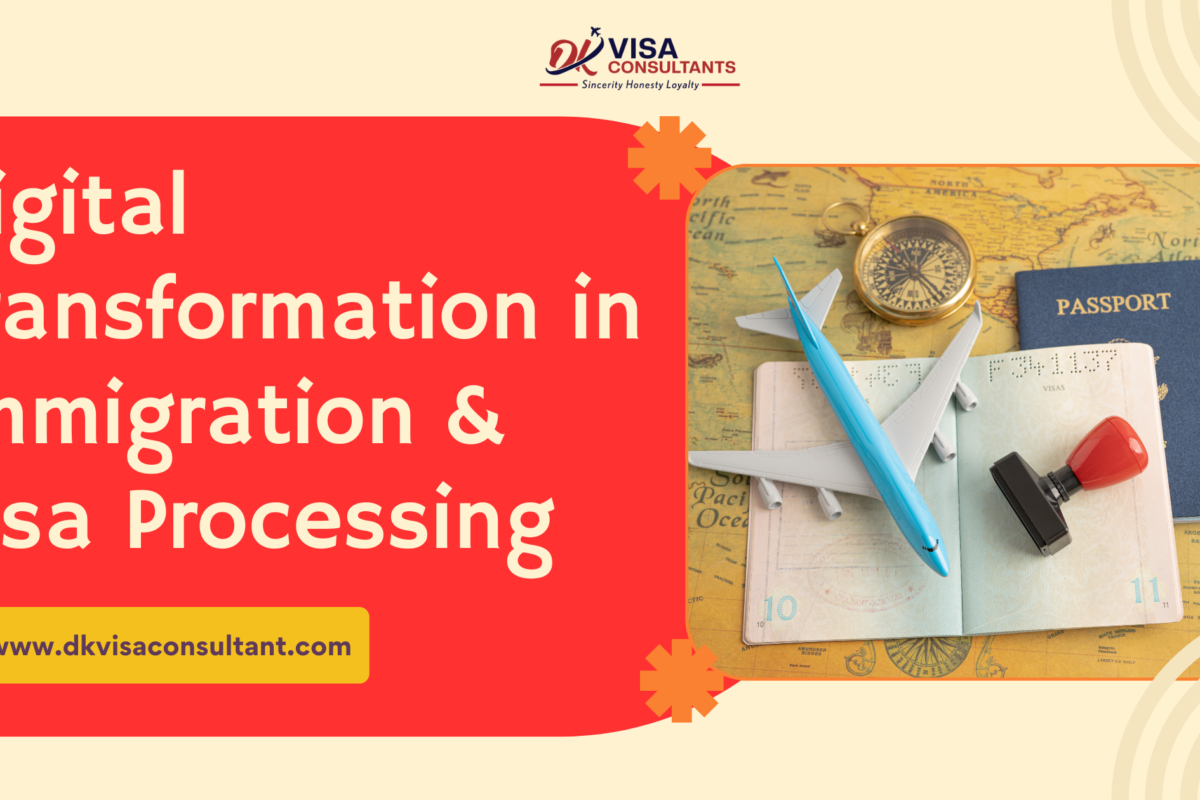Digital transformation in immigration and visa processing is reshaping how individuals connect with new opportunities across borders. Traditional methods once relied heavily on paper forms, manual checks, and lengthy wait times. Today, governments and immigration authorities across the world are adopting innovative technologies that make processes faster, safer, and more transparent. For applicants, this shift means a smoother experience, while for governments, it ensures better efficiency and stronger security. The digital wave in immigration is not just a change in tools—it represents a complete re imagination of how global mobility is managed.
Journey from Paper to Digital Immigration
Immigration has always played a critical role in shaping global economies, cultures, and societies. For decades, visa processing systems were weighed down by bureaucracy. Physical document submissions, in-person interviews, and prolonged waiting periods were the norm. Misplaced documents, delayed responses, and limited access to information often added to applicant frustrations.
The move towards digitalisation began gradually, with online application forms and appointment bookings. Over time, new technologies like artificial intelligence, biometrics, and blockchain revolutionised the landscape. Today, many nations are implementing end-to-end digital systems where everything—from application submission to decision-making—happens online. This evolution reflects a broader trend towards efficiency, transparency, and inclusivity in immigration systems.
Why Digital Transformation is Essential in Immigration
Several forces drive the adoption of digital solutions in immigration and visa processing:
- Global Mobility Growth – Rising international travel for study, work, and tourism demands scalable systems that can process higher volumes.
- Enhanced Security Needs – Preventing identity fraud and forgery requires advanced verification technologies.
- Efficiency in Government Operations – Automation reduces administrative costs and eliminates repetitive tasks.
- Pandemic Influence – COVID-19 highlighted the need for touchless, remote, and digital-friendly immigration solutions.
- Competition Among Nations – Countries compete to attract skilled talent and international students through faster and reliable visa systems.
Technologies Powering Digital Immigration
- Artificial Intelligence and Machine Learning
AI algorithms are widely used to analyse application data, verify documents, and detect fraudulent patterns. Machine learning models help predict risks, classify applicants, and even provide faster decision-making without human intervention. For example, automated chatbots assist applicants 24/7, while intelligent case management systems speed up background checks.
- Blockchain Technology
Blockchain ensures secure and tamper-proof storage of sensitive immigration data. It enables decentralised verification of travel history, educational credentials, and identity records. Many governments are exploring blockchain to prevent document forgery and to create globally interoperable databases for visa validation.
- Biometric Identification
Facial recognition, iris scans, and fingerprint verification have become integral in immigration systems. Biometrics ensures accurate identity verification, reduces the risk of impersonation, and speeds up border control. Automated e-gates at airports are prime examples of this transformation.
- Robotic Process Automation (RPA)
RPA is being used to handle repetitive tasks such as data entry, form validation, and compliance checks. This reduces workload for immigration officers, allowing them to focus on complex cases while ensuring accuracy and consistency in application processing.
- Cloud Computing
Cloud-based immigration platforms facilitate global accessibility, data sharing, and scalability. Applicants can submit documents online, track applications in real time, and communicate with immigration authorities seamlessly. For governments, cloud infrastructure ensures resilience and efficiency.
Data Analytics and Predictive Modelling
Advanced analytics help authorities identify migration patterns, forecast application volumes, and allocate resources effectively. Predictive modelling also assists in identifying potential overstays, visa misuse, and fraudulent activities before they occur.
- Digital Identity and e-Visa Systems
Digital ID verification allows secure authentication of applicants without physical documentation. e-Visa platforms enable travellers to apply and receive visas electronically, eliminating the need for embassy visits. Countries like India, UAE, and Australia have already adopted extensive e-Visa frameworks.
Benefits of Digital Transformation in Immigration
- Faster Processing Times
Automated systems drastically reduce waiting times. What once took weeks or months can now be completed in days or even hours.
- Improved Accuracy and Security
AI-powered verification and blockchain integration reduce human errors and make it nearly impossible to tamper with sensitive records.
- Enhanced Applicant Experience
Digital platforms allow applicants to apply remotely, track progress online, and receive instant updates, creating a user-friendly experience.
- Cost Savings for Governments
Automation and paperless systems lower administrative expenses, staffing requirements, and infrastructure costs.
- Transparency and Accountability
Real-time tracking, automated decision-making, and digital records improve trust in immigration authorities by minimising corruption and bias.
Challenges in Implementing Digital Immigration Systems
Despite the benefits, digital transformation in immigration faces several obstacles:
- Data Privacy Concerns – Handling sensitive biometric and personal data requires strict cybersecurity measures.
- Digital Divide – Not all applicants have equal access to digital tools, especially in developing regions.
- Integration Issues – Linking legacy systems with modern digital solutions can be complex and costly.
- Cybersecurity Threats – Immigration systems are prime targets for cyberattacks, requiring robust security frameworks.
- Legal and Ethical Concerns – AI-based decision-making raises questions about fairness, bias, and accountability.
Case Studies: Global Examples of Digital Immigration Systems
- Estonia – The Digital Nation
Estonia is renowned for its e-Residency program, which allows foreign entrepreneurs to establish and manage businesses entirely online. Its digital-first approach in immigration showcases efficiency and innovation.
- United Arab Emirates – Smart Immigration Solutions
The UAE introduced smart gates and biometric verification at airports, significantly reducing processing times. Its fully digital residence visa and Emirates ID system set a global benchmark.
- Canada – AI-Powered Immigration
Canada uses AI tools to triage visa applications, ensuring faster processing for straightforward cases while complex ones receive human review. This hybrid system balances efficiency with fairness.
- Australia – e-Visa Leadership
Australia’s e-Visa framework allows applicants worldwide to apply, pay, and track their visa applications entirely online, showcasing convenience and accessibility.
Singapore – Automated Border Control
Singapore deploys advanced biometrics and AI-driven border management systems, making it one of the fastest and most secure immigration systems globally.
Future of Immigration and Visa Processing
The coming years are expected to bring:
- Global Digital Identity Systems – Universal recognition of digital IDs for seamless cross-border travel.
- Contactless Airports – Fully biometric-driven travel requiring minimal physical documents.
- AI-Powered Border Management – Predictive tools for risk detection and fraud prevention.
- International Data Integration – Countries collaborating on shared databases for safer mobility.
- Ethical AI Frameworks – Ensuring fairness, inclusivity, and transparency in automated decisions.
Conclusion
Digital transformation in immigration and visa processing represents a fundamental shift in how global mobility is managed. By adopting technologies such as AI, biometrics, blockchain, and cloud computing, governments are building systems that are faster, safer, and more transparent. While challenges like data privacy, cybersecurity, and accessibility must be addressed, the overall impact is overwhelmingly positive. The combination of technology with human oversight ensures fairness, security, and inclusivity. For applicants, this transformation brings a smoother journey, while for governments, it strengthens efficiency and trust.
FAQ
Q1. What is digital transformation in immigration?
Ans: It is the use of advanced technologies like AI, biometrics, blockchain, and e-Visa platforms to make immigration processes faster, safer, and more efficient.
Q2. How does AI support visa processing?
Ans: AI assists in verifying documents, detecting fraud, categorising applications, and providing instant assistance through chatbots.
Q3. Are e-Visas reliable?
Ans: Yes, e-Visa systems use secure encryption and biometric authentication to protect applicant data and prevent misuse.
Q4. What benefits do digital immigration systems bring?
Ans: They reduce processing times, lower costs, improve accuracy, enhance applicant experience, and increase transparency.
Q5. What risks come with digital transformation in immigration?
Ans: Cybersecurity threats, data privacy concerns, technical issues, and unequal digital access are among the main risks.
Q6. Which countries are most advanced in digital immigration?
Ans: Estonia, UAE, Canada, Australia, and Singapore are global leaders in adopting digital-first immigration frameworks.
Q7. Will technology replace human immigration officers?
Ans: No, while automation handles repetitive tasks, human judgement is crucial in complex and humanitarian cases.
Q8. How does blockchain improve immigration processes?
Ans: Blockchain ensures secure, tamper-proof storage of records, making document verification more reliable and efficient.
Q9. Did the pandemic influence digital immigration?
Ans: Yes, COVID-19 accelerated the adoption of contactless and online immigration systems, highlighting the need for remote-friendly solutions.
Q10. What will immigration look like in the future?
Ans: The future will likely include universal digital IDs, biometric-driven travel, AI-powered border systems, and globally integrated data networks.






